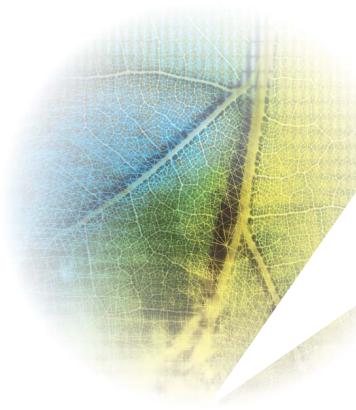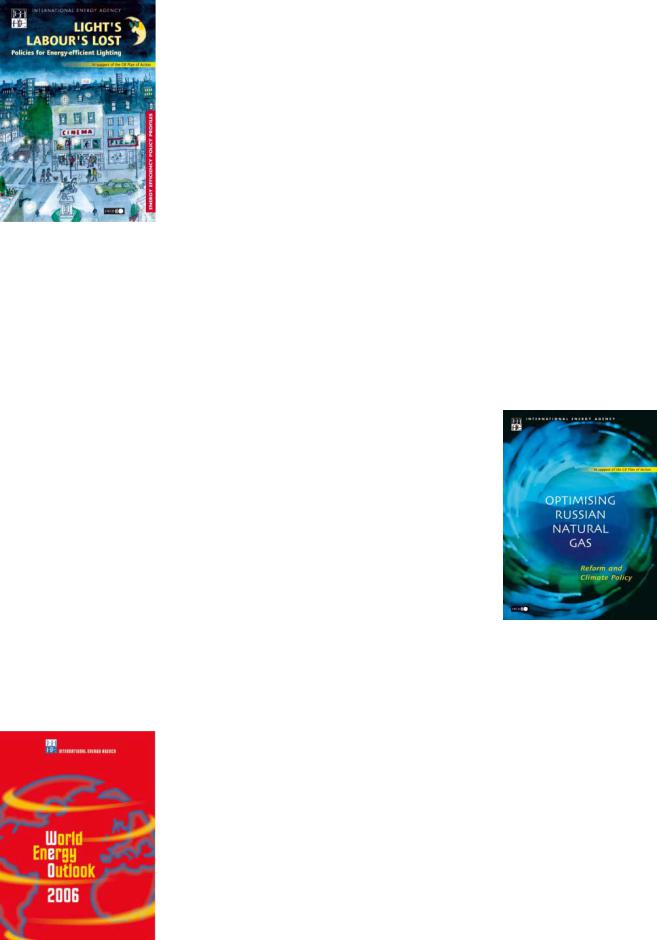
СТАТИСТИКА 1 / Международное энергетическое агентство www.IEA.org / Публикации разные / g8brochureStPet
.pdf
I n s u p p o r t o f t h e G 8 P l a n o f A c t i o n

! "

In July 2005, the G8 invited the International Energy Agency (IEA) to attend its Summit in Gleneagles (United Kingdom). Participants in this important meeting placed high priority on the development of strategies to mitigate climate change, secure clean energy and achieve sustainable development. Their goal was to ensure a “clean, clever and competitive energy future”. The resulting Gleneagles Plan of Action mandates the IEA to identify pathways for G8 policy makers to realise this objective. Key priorities were identified:
Alternative energy scenarios and strategies.
Increased energy efficiency, especially in buildings, appliances, transport and industry.
Cleaner use of fossil fuels.
Carbon capture and storage.
Renewable energy.
Enhanced international co-operation.
These six strategic areas draw on the IEA’s existing expertise, but increased efforts are now underway. The IEA is building on previous work, broadening its focus and launching new initiatives to evaluate the potential of and to promote each one of these priorities.
A number of projects require close co-operation with Russia, with the “Plus Five” countries (Brazil, China, India, Mexico and South Africa), with industry, with the World Bank and other international financial institutions, and with UN agencies and the IEA’s technology network. All 26 IEA member countries are actively engaged. Some early results are reported below. In the meantime, IEA participation in the G8 Summit in St. Petersburg in July 2006 presents an opportunity to review progress and report on work supporting the G8 process. Ultimately this will lead to further efforts and more comprehensive results to report to the German and Japanese G8 Summits in 2007 and 2008 respectively.
For more information on the IEA or any of the work and activities mentioned in this document, please see www.iea.org/G8. Questions may be addressed to G8Programme@iea.org.

#
A thorough analysis of “best practice” in policies promoting energy-efficient appliances, covering both recent trends in energy usage and developments in countries belonging to the IEA, the G8 and the “Plus Five”. Potential measures to improve efficiency are under consideration. The IEA Secretariat identified some concrete actions that governments should take now. These proposals utilise existing technologies and are available at low or even negative cost:
Limiting standby-power use to 1 Watt for electric appliances. The potential savings in the IEA would add up to 20 GW (or the equivalent of installed capacity of the Netherlands) by 2020.
Establishing efficiency standards for television “set-top” boxes and digital television adaptors. The expected savings at a global level would be as much as 8 GW (or the equivalent of installed capacity of New Zealand) by 2020.
Achievingmoreenergy-efficientlighting.Theexpectedsavingsfromadopting best practice is about 38% of global lighting energy consumption.
A comprehensive review of building codes and other measures affecting the building sector, leading to possible recommendations on policies to reduce energy consumption in both new and existing buildings.
An overview of how emerging and existing technologies can enhance energy efficiency and reduce CO2 emissions in the industrial sector in both OECD and non-OECD countries.
A wide-ranging analysis of the potential for energy-efficiency improvements in surface transport, providing guidance for better policy development in both OECD and non-OECD countries. A first potential action identified by the IEA Secretariat can be implemented now at little or no cost:
Implementing a fuel-efficient tyre programme. The expected global fuel savings from tires with low rolling resistance would range from 1-5% when fully implemented of vehicle consumption.

! " #$%
A study on near-term opportunities for carbon capture and storage, a report on capture-ready plant concept, and a report on legal aspects of storing CO2. All three initiatives are designed to speed-up market introduction of CCS.
& &
An assessment of the global potential to improve generation efficiency in fossil fuel-fired power plants, especially those using coal. It includes the extension of a global database on efficiency of electricity generation, case studies on recently constructed plants, reports on best practices in power plant operation and recommendations for upgrades, replacements and future developments.
' !
Ananalysisoftheabilityofconventionalelectricitygrids to absorb renewable power generation technologies, while retaining secure reliable supplies. The goal is to understand conditions in which renewables can become an integral and efficient part of the grid.
An activity that draws on current and new-generation energy indicators providing “state-of-the-art” data and analysis of energy use as well as energy efficiency developments in OECD and non-OECD countries.
# ' ( ) %
An initiative that raises the profile of existing technology networks and improves links between international efforts. Key stakeholders committed to participate in further NEET activities at the Initiative’s launch on 3 May 2006 during the United Nations Commission on Sustainable Development meeting.
A newsletter that provides timely reports and updates on energy technology collaboration and developments across the IEA’s global network.
The IEA’s fundamental role of producing global energy data and statistics
provides an engine for all Agency analysis.

#
' ! *
+,+#& ! -../%
To increase the market share of renewable energy technologies, technological advancement must accelerate and subsequently reduce costs. RD&D initiatives, if properly
designed and implemented, can help to achieve this goal. This publication reviews the current status of the renewable energy technologies and provides guidance on their development.
0 *
$,$ -.1.#2 -../%
The IEA’s major technology publication, Energy Technology Perspectives, is a groundbreaking study that demonstrates how energy technologies can make a difference in a series of global scenarios to 2050. Energy Technology Perspectives provides detailed technology and policy insights to help governments craft sustainable solutions.

3 ! 3 *
$
4
#2 -../%
Energy efficiency can play a key role in meeting energy security and environmental goals, especially since technologies exist to reduce energy consumption at acceptable cost. This comprehensive study documents the broad range of existing energy-efficient lighting and assesses policy measures required to transform current practice.
5
* 5
5#2 -../%
The world’s largest natural gas producer and exporter, Russia has enormous energy-saving potential. This book analyses and estimates the potential gas savings and the associated reductions in greenhouse gas emissions in the oil extraction (gas flaring), gas transmission and distribution sectors. It also describes Russia’s emerging climate policy and institutional framework.
6 (-../# 0 5! -../%
Going beyond previous WEO scenarios, the IEA’s annual flagship publication projects the impact that targeted policies and more robust deployment of energy technologies could have on sustainability to 2030. It also provides indepth analysis of economics of biofuels, Brazil’s impact on global energy markets, cleaner fuels for cooking and heating for developing countries, nuclear energy, and technology prospects beyond 2030.

© OECD/IEA, 2006
The International Energy Agency (IEA) is an autonomous body which was established in November 1974 within the framework of the Organisation for Economic Co-operation and Development (OECD) to implement an international energy programme. It carries out a comprehensive programme of energy co-operation among twenty-six of the OECD’s thirty member countries. The basic aims of the IEA are:
To maintain and improve systems for coping with oil supply disruptions.
To promote rational energy policies in a global context through co-operative relations with non-member countries, industry and international organisations.
To operate a permanent information system on the international oil market.
To improve the world’s energy supply and demand structure by developing alternative energy sources and increasing the efficiency of energy use.
To assist in the integration of environmental and energy policies.
TheIEAmembercountriesare:Australia,Austria,Belgium,Canada, the Czech Republic, Denmark, Finland, France, Germany, Greece, Hungary, Ireland, Italy, Japan, the Republic of Korea, Luxembourg, the Netherlands, New Zealand, Norway, Portugal, Spain, Sweden, Switzerland, Turkey, the United Kingdom and the United States. The European Commission takes part in the work of the IEA.
